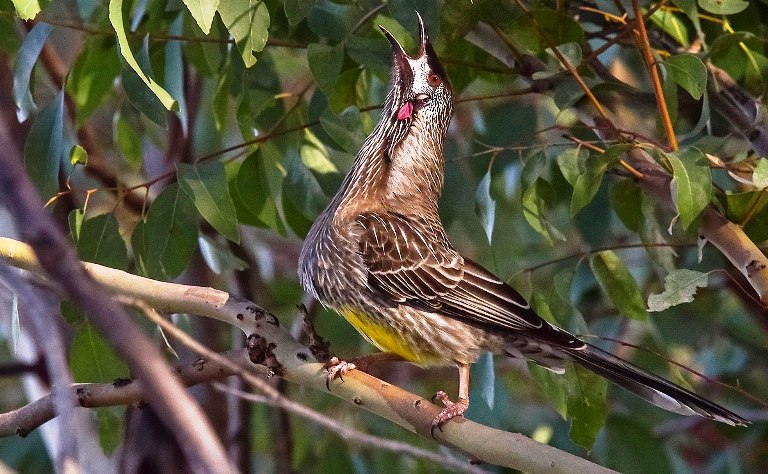Red Wattlebird (Anthochaera carunculata) so named for the lobes of skin on their cheeks, belong to the honeyeaters, the largest and most typical family of birds in Australia. The honeyeater is an aggressive tree and shrub-dwelling bird that rifles pollen and nectar from flowers with its four-pronged brush-tipped tongue.
Many of them are nomadic migratory foragers, following the cyclic and seasonal flushes of flowers in the countryside. They eat insects as well as fruit, and they follow the cyclic and seasonal flushes of flowers in the countryside. There are no exceptions when it comes to red wattlebirds. Throughout southern Australia, these birds are commonly found in eucalypt woodlands and forests.

They roam along established flight paths in search of concentrated flowering rich enough to support them in loose nomadic bands of 10 to 100 birds or more after breeding. A variety of flowering plants such as eucalypts, banksias, grevilleas, and hakeas attract insects and produce copious amounts of nectar.
A wattle bird or smaller honeyeater will frequently establish feeding territories around these sources and advertise them with raucous calling. Honeybees are also hunted as they fly in and out of their hives as they catch insects on the wing or scoop them up from leaves and bark. The Wattlebird often enters well-shrubbed urban orchards and gardens, becoming a pest.
When food supplies dwindle, they move on and, in winter, generally leave higher altitudes and travel north to areas with stable supplies. Several remain throughout the year. During breeding, flocks disperse, and pairs-possibly permanent-nest away from each other. Most often during the breeding season, males and females call in duets to keep pair bonds strong. The young are fed insects by both parents for a few weeks after they have fledged.
There are several names for this bird, including Gillbird and Wattled Honeyeater. The tail of the Red Wattlebird is tapered and measures about 330-350 mm long. There is little difference between the two adults. Male birds, however, have blacker crowns, shafts streaked with white, and gray-brown upper parts. Wings and tails are grey-brown with white tips that are narrow and broad, respectively.
A rounded pink-red wattle surrounds the grey-white cheeks. White heavily streaked brown-grey at the throat, flanks, and undertail; yellow at the belly center. The eyes are red and the bill is black. There is pink flesh on the feet. Immature birds have a duller appearance, a vestigial wattle, browner eyes; wattles fill out in the first year.
When feeding, the Red Wattlebird hacks coughs chok-ch-chok or yak-yak-yak; the female calls tew-tew-tew. There is a loud chok in alarm from the single.
In duets, Red Wattlebirds sing a mellow, ringing tew-tew-tew-tew by the female, followed by a deep, harsh cough by the male; bill snaps are often used to introduce the song. Breeding and nesting are mostly in July-December; sometimes in autumn. Birds build nests in the outer foliage of trees and bushes, perched 3-15 meters above the ground.
Nests are rough, small cups made of grass and twigs lined with feathers, hair, or down. Two to three pink-buff eggs are oval-to-tapered-oval, about 33 x 23 mm, with sparse red-brown and purple spots. There are eucalypt woodlands, forests, and mallee heaths in the southern part of the mainland near the coast. There are no races on the mainland or in Kangaroo Stand, in South Australia.
Related Reading – Yellow Wattlebird – The World’s Largest Honeyeater







